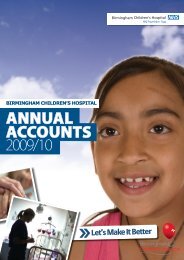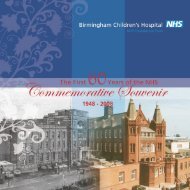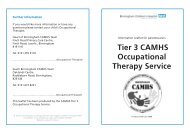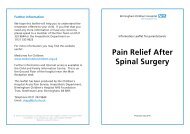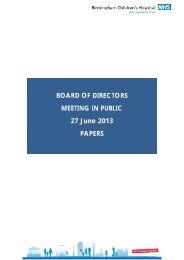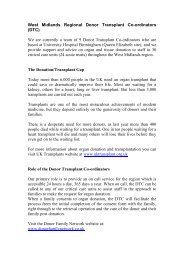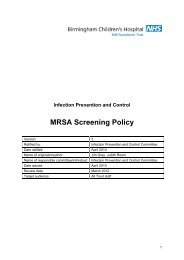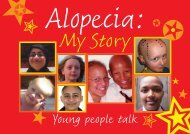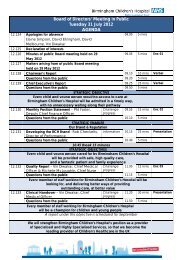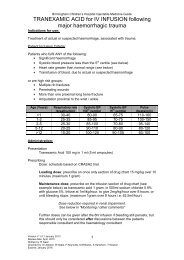Nurses Day! - Birmingham Children's Hospital
Nurses Day! - Birmingham Children's Hospital
Nurses Day! - Birmingham Children's Hospital
Create successful ePaper yourself
Turn your PDF publications into a flip-book with our unique Google optimized e-Paper software.
At <strong>Birmingham</strong> Children’s <strong>Hospital</strong> we also carry<br />
out world-leading research and treatment for<br />
children with rare diseases which affect less than<br />
one in 100,000 children. Although rare diseases<br />
can affect many different parts of the body, the<br />
one thing that is common is that they all require<br />
care and treatment from several different specialist<br />
areas and if unrecognised they can lead to severe<br />
disabilities.<br />
We are the second largest provider of nationally<br />
commissioned rare diseases services in the UK<br />
with 11, and because of our expertise we aspire to<br />
become a National Rare Diseases Centre and will<br />
be working towards this over the next year.<br />
In March 2013, we became the first centre in the<br />
UK to use a novel new treatment for children with<br />
a rare and life-threatening liver disease - Crigler<br />
Najjar Syndrome. The trial aims to replace the<br />
diseased liver cells by restoring normal function<br />
with the infusions of liver stem cells. The hope is<br />
that these healthy stem cells will ‘seed’ into the<br />
liver and correct the faulty metabolism that children<br />
with this disease suffer with. One patient so far has<br />
had this treatment with more lined up. Results from<br />
this trial should become available within the next<br />
two years.<br />
In July 2012 we were selected as one of four<br />
centres to join a new year-long pilot study for<br />
the Department of Health’s National Newborn<br />
Screening Programme to test for some additional<br />
rare diseases.<br />
Currently, all babies are tested at birth for five<br />
conditions through the ‘heel prick test’. As part of<br />
the pilot, newborns are being tested for five more<br />
to look at outcomes and whether they should<br />
be permanently added to the national screening<br />
programme.<br />
The pilot is going well and to date we have picked<br />
up two cases at <strong>Birmingham</strong> Children’s <strong>Hospital</strong> –<br />
one mild isovaleric aciduria and one maple syrup<br />
urine disease – which is a great result as it means<br />
that we can now treat the children much earlier,<br />
prevent severe complications and help them live<br />
longer and healthier lives.<br />
One of these children, Habul Khatoon from<br />
<strong>Birmingham</strong> was diagnosed in October 2012 with<br />
maple syrup urine disease when she was just a<br />
few days old. This is a serious genetic metabolic<br />
disorder which stops the body breaking down<br />
amino acids in protein rich food. If these acids<br />
accumulate and are left or not managed properly,<br />
it can lead to coma, brain damage and death in<br />
newborn babies.<br />
Thanks to the early intervention and ongoing<br />
treatment from our metabolic team, Habul is<br />
growing and developing normally and looking<br />
forward to a much brighter future.<br />
Case study<br />
BACK TO CONTENTS PAGE<br />
Noah and Ruby<br />
from Sandwell<br />
Baby Habul and mum Fahmeeda Khatoon pictured with Inherited Metabolic Specialists<br />
Professor Anita MacDonald and Dr Anupam Chakropani<br />
Rebekah Youlden and Arron Harvey from Sandwell<br />
are supporting the Newborn Screening Programme<br />
pilot as their two youngest children, Noah (4) and<br />
Ruby (2) have glutaric aciduria type 1 (GA1), which<br />
means that they cannot break down protein which<br />
causes harmful substances to build up in their<br />
bodies.<br />
Noah was just 10 months old when he first became<br />
ill and it wasn’t until he had spent three weeks in a<br />
local hospital that he was diagnosed with GA1. The<br />
length of time from birth until his diagnosis meant<br />
that damage to Noah’s brain had already begun.<br />
He is now in a wheelchair but can take steps in his<br />
specially built walker, he attends school and can eat<br />
with his family after spending two and a half years<br />
being fed through a nasogastric tube.<br />
40 41<br />
Two year old Ruby on the other hand was<br />
diagnosed at just 12 days old and started on a<br />
limited protein diet and medication straight away to<br />
lessen the damage to her body and brain and she<br />
is developing normally for her age.<br />
Her parents are all too aware of the importance of<br />
early diagnosis. Mum Rebekah said: “Noah is a<br />
lovely little boy who always has a smile on his face<br />
but people find it hard to believe that he and Ruby<br />
have the same disease because Ruby is walking<br />
and talking and Noah is in a wheelchair and can’t<br />
do all the things his sister can. If the heel prick test<br />
had been able to test for GA1, Noah’s life would<br />
have been so different.”




